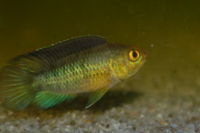Difference between revisions of "Nannacara anomala"
From The Aquarium Wiki
m (Changed minimum tank size from 25 to 10 gallons. These fish are small…) |
|||
| (One intermediate revision by one other user not shown) | |||
| Line 26: | Line 26: | ||
|min_sg=1 | |min_sg=1 | ||
|max_sg=1 | |max_sg=1 | ||
| − | |min_tank_size= | + | |min_tank_size=10 |
|min_tank_size_unit=gal | |min_tank_size_unit=gal | ||
|min_ph=6.0 | |min_ph=6.0 | ||
| Line 36: | Line 36: | ||
|max_water_hardness=19 | |max_water_hardness=19 | ||
}} | }} | ||
| − | + | ||
| − | + | == Sexing == | |
| − | + | :Females are noticeably smaller than males. Females have different colouration than males, see identification. | |
| − | + | ||
| − | + | ||
| − | + | == Tank compatibility == | |
| − | + | :These small cichlids can be kept as a pair in a species tank, or as part of a larger community tank. Generally peaceful, but two males may fight. | |
| − | + | ||
| − | + | ||
| + | == Diet == | ||
| + | :Will accept most foods including pellet and flake (provided they are a tank-bred strain), as well as [[brine shrimp]], [[bloodworm]] and [[daphnia]]. | ||
| + | |||
| + | |||
| + | == Feeding regime == | ||
| + | :Feed once or twice a day. | ||
| + | |||
| + | |||
| + | == Environment specifics == | ||
| + | :Prefers a tank with plenty of hiding places. Does best in soft acidic water without bright light. | ||
| + | |||
| + | |||
| + | == Behaviour == | ||
| + | :A generally peaceful dwarf cichlid that is mostly mid-bottom dwelling. A cave-brooding substrate spawner, a pair will care for a spawn with the female caring for the brood and the male guarding the territory. | ||
| + | |||
| + | |||
| + | == Identification == | ||
| + | :Males are blue-green when adult, with banding only when in a subdued mood. Females are orange-brown with dark longitudinal bands. Males have dorsal and anal fin extensions. | ||
| + | |||
| + | |||
{{Categories | {{Categories | ||
|Category=Fish, Fish (Freshwater), Cichlids, Cichlids (American), Dwarf Cichlid | |Category=Fish, Fish (Freshwater), Cichlids, Cichlids (American), Dwarf Cichlid | ||
Latest revision as of 13:04, 12 March 2022
Golden Dwarf Cichlid
Nannacara anomala
38 Litres (10 US G.)
5.1-6.4cm (2-2.5 ")
Freshwater
6.0 - 8.0
22 -25 °C (71.6-77°F)
5-19 °d
1:3 M:F
5-8 years
Family
Cichlidae
Contents
Additional names
- Golden Dwarf Cichlid, Goldeneye Cichlid
Additional scientific names
- Acara anomala, Acara punctulata, Nannacara taenia
Sexing[edit]
- Females are noticeably smaller than males. Females have different colouration than males, see identification.
Tank compatibility[edit]
- These small cichlids can be kept as a pair in a species tank, or as part of a larger community tank. Generally peaceful, but two males may fight.
Diet[edit]
- Will accept most foods including pellet and flake (provided they are a tank-bred strain), as well as brine shrimp, bloodworm and daphnia.
Feeding regime[edit]
- Feed once or twice a day.
Environment specifics[edit]
- Prefers a tank with plenty of hiding places. Does best in soft acidic water without bright light.
Behaviour[edit]
- A generally peaceful dwarf cichlid that is mostly mid-bottom dwelling. A cave-brooding substrate spawner, a pair will care for a spawn with the female caring for the brood and the male guarding the territory.
Identification[edit]
- Males are blue-green when adult, with banding only when in a subdued mood. Females are orange-brown with dark longitudinal bands. Males have dorsal and anal fin extensions.
Pictures[edit]
External links[edit]
- Fishbase (Mirrors:
 )
)

